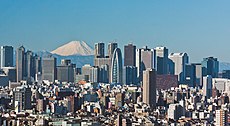라이만 연속 광자
Lyman continuum photonsLyman 연속 광자(약칭)LyC), 즉 Ly continuum 광자 또는 Lyc 광자로 단축된 광자는 Lyman 한계 이상의 광자 에너지에서 별에서 방출되는 광자다.수소는 LyC를 흡수함으로써 이온화된다.빅토르 슈만의 자외선 발견에서 1906년부터 1914년까지 테오도르 리만은 원자 수소가 특정 주파수(또는 파장)에서만 빛을 흡수한다는 것을 관찰했고 라이만 시리즈는 따라서 그의 이름을 따서 명명되었다.[1][2]Lyman 시리즈의 모든 파장은 자외선 대역에 있다.이 정량화된 흡수 동작은 이온화 에너지라고 알려진 에너지 한계까지만 발생한다.중성 원자 수소의 경우 최소 이온화 에너지는 라이먼 한계치와 동일하며, 광자는 원자를 완전히 이온화시킬 수 있는 충분한 에너지를 가지고 있어 자유 양성자와 자유 전자가 된다.이 에너지(이 파장 이하) 위에 모든 파장의 빛이 흡수될 수 있다.이것은 에너지 스펙트럼에서 연속체를 형성한다; 스펙트럼은 낮은 에너지에서 보이는 많은 이산 선으로 구성되기 보다는 연속적이다.[3][4]
Lyman 한계치는 91.2nm(912 å)의 파장으로, 주파수 329만 GHz와 광자 에너지 13.6 eV에 해당한다.[3]LyC 에너지는 대부분 전자기 스펙트럼의 자외선 C 부분에 있다(Lyman 시리즈 참조).X선과 감마선도 수소 원자를 이온화시키겠지만, 별의 광구에서 방출되는 X선과 감마선은 훨씬 적다. - Lyc는 주로 UV-C이다.원자 수소의 이온화로 이어지는 광자 흡수 과정은 역방향으로 발생할 수 있다: 전자와 양성자가 충돌하여 원자 수소를 형성할 수 있다.만약 두 입자가 천천히 (운동 에너지를 무시할 수 있도록) 움직이고 있었다면, 원자가 생성될 때 방출하는 광자는 이론적으로 13.6 eV가 될 것이다(현실적으로 원자가 흥분된 상태에서 형성되면 에너지는 줄어들 것이다).더 빠른 속도에서 초과(키네틱) 에너지는 더 낮은 파장의 광자(더 높은 에너지)로서 복사된다(그러나 운동량은 보존되어야 한다).따라서 13.6 eV 이상의 에너지를 가진 광자는 원자수소를 형성하는 에너지 넘치는 양성자와 전자의 조합에 의해 방출되고 광이온화 수소로부터 방출된다.
참고 항목
- 발머 한계
- 리만알파블롭
- 리만알파 숲
- 리만 브레이크 은하
- 라이먼 시리즈
- Haro 11 - Lyman 연속 광자를 '유출'하는 지역 우주의 두 은하 중 하나.
- 톨롤로-1247-232 - 리만 연속 광자를 '유출'하는 지역 우주에서 두 번째 은하.
- 완두콩 은하 - 적어도 두 개의 그린피스가 LyC 'leakers'로 의심된다.
참조
- ^ Lyman, Theodore (1906), "The Spectrum of Hydrogen in the Region of Extremely Short Wave-Length", Memoirs of the American Academy of Arts and Sciences, New Series, 13 (3): 125–146, doi:10.2307/25058084, ISSN 0096-6134, JSTOR 25058084,
In a preliminary paper1 the author has given the wave-length of more than one hundred and thirty lines in the region of the spectrum lying between the values 1850 and 1030 tenth metres. It is the object of the present paper to compare the results obtained by the author with those given by Schumann; to describe the apparatus used in this research and to call attention to some new facts which have come to light since the publication of the first notice.
- ^ Lyman, Theodore (1914), "An Extension of the Spectrum in the Extreme Ultra-Violet", Nature, 93 (2323): 241, Bibcode:1914Natur..93..241L, doi:10.1038/093241a0
- ^ a b Dipankar Bhattacharya (August–December 2003). "Matter and Radiation" (PDF). Fundamentals of Astrophysics. India: Inter-University Centre for Astronomy and Astrophysics.
In most situations, the total emission by the free-free process far exceeds the recombination radiation, but the recombination radiation can introduce characteristic spectral features at ionisation thresholds in the continuum radiation. For Hydrogen, the highest ionisation threshold, called the Lyman Limit, corresponds to an energy of 13.6 eV or an wavelength of 912Å. Recombination radiation from Hydrogen at wavelengths shorter than this is called the “Lyman continuum”.
- ^ "Lyman limit". A Dictionary of Astronomy. 1997. Archived from the original on May 23, 2011.
Lyman limit The short-wavelength end of the hydrogen Lyman series, at 91.2 nm. It corresponds to the energy required for an electron in the hydrogen ground state to jump completely out of the atom, leaving the atom ionized.



